Comprehensive Business Strategy Report on Unilever - CECOS
VerifiedAdded on 2023/06/11
|14
|4987
|411
Report
AI Summary
This report provides a comprehensive analysis of Unilever's business strategies, starting with an introduction to the company and its global presence. It delves into the strategic context of Unilever, including a SWOT analysis identifying the company's strengths, weaknesses, opportunities, and threats. The report further examines the impact of the macro environment using PESTLE analysis and Porter's Five Forces to understand the competitive landscape. It also explores Unilever's internal environment and capabilities through McKinsey's 7S model. The analysis covers major strategies adopted by Unilever, offering recommendations for strategic management and concluding with a strategic management plan. This document is available on Desklib, a platform offering study tools and solved assignments for students.
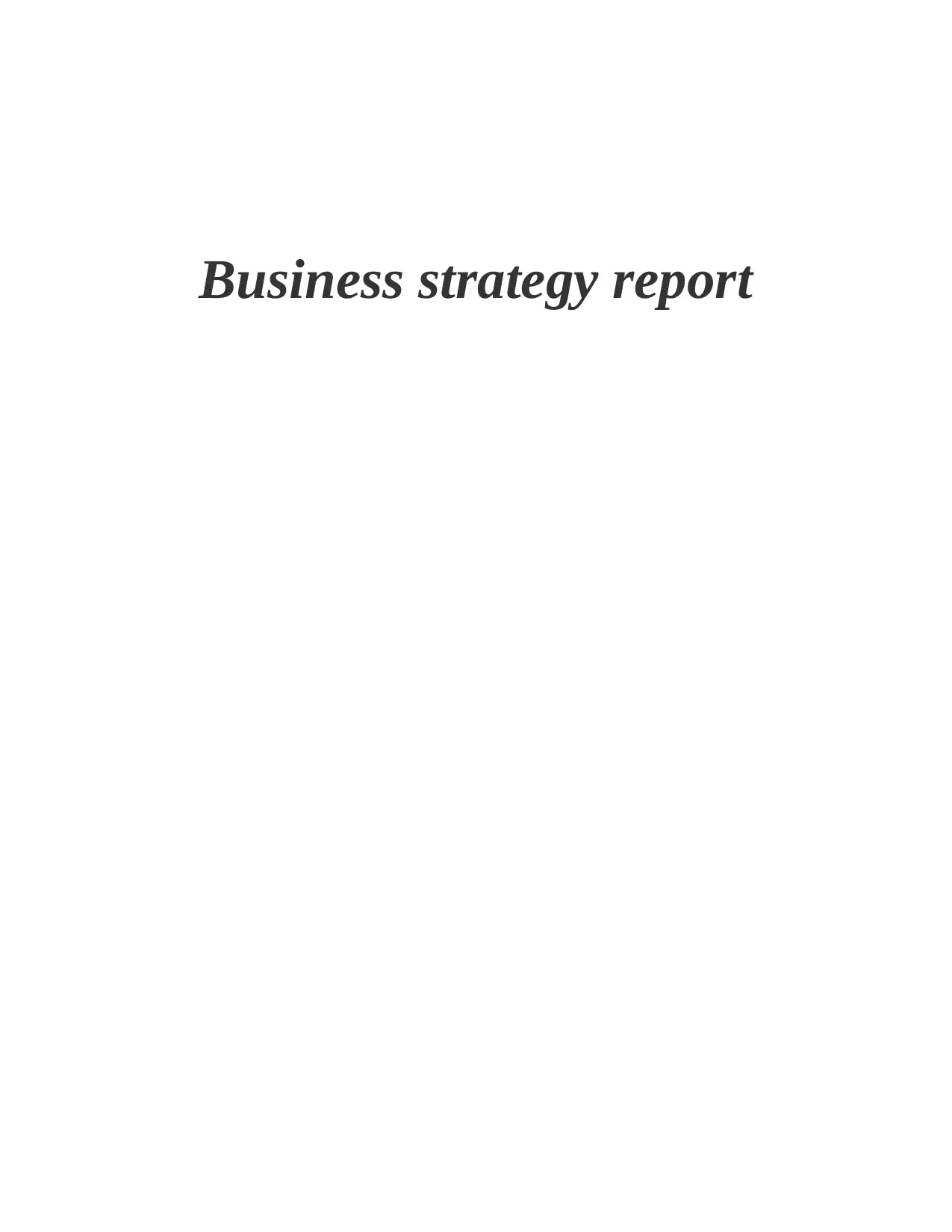
Business strategy report
Paraphrase This Document
Need a fresh take? Get an instant paraphrase of this document with our AI Paraphraser
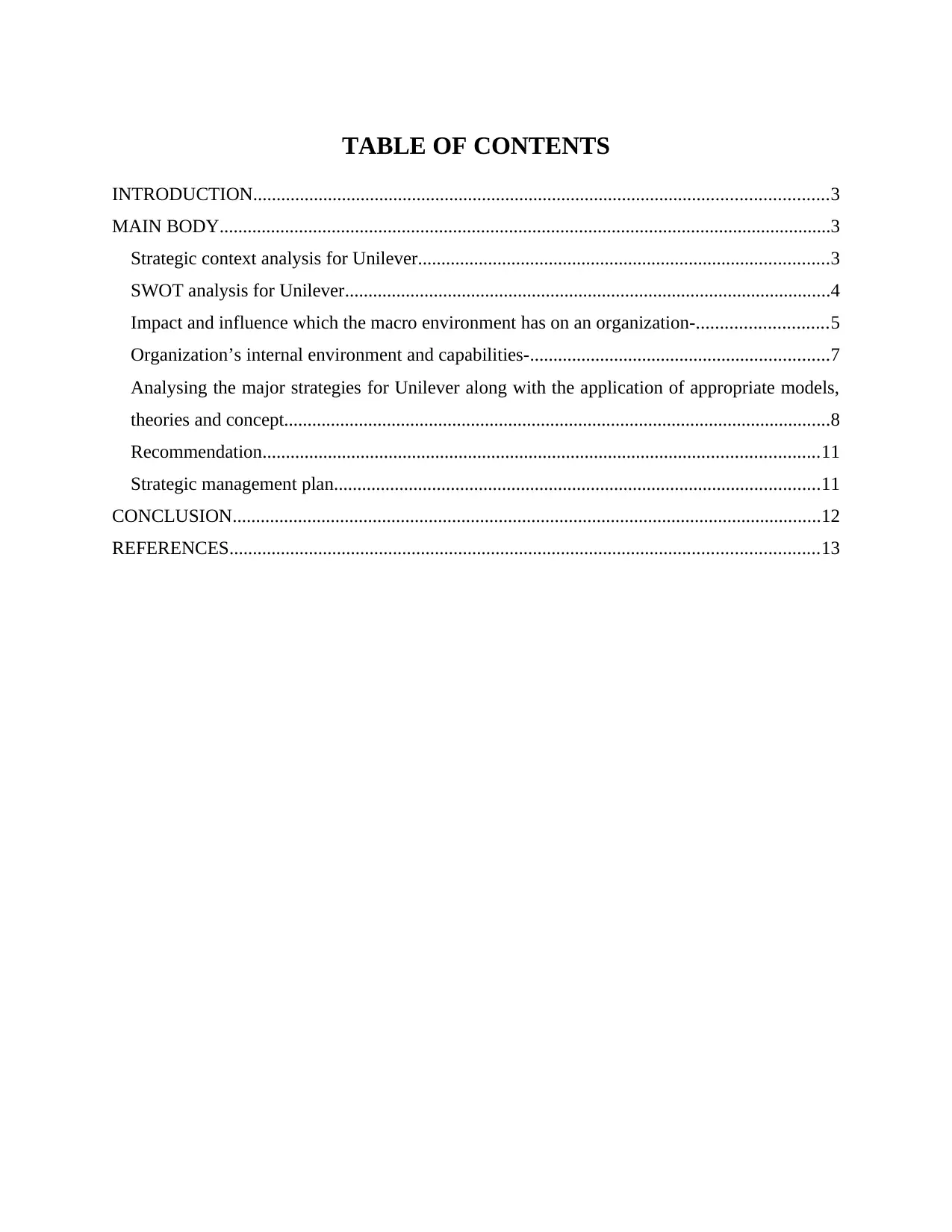
TABLE OF CONTENTS
INTRODUCTION...........................................................................................................................3
MAIN BODY...................................................................................................................................3
Strategic context analysis for Unilever........................................................................................3
SWOT analysis for Unilever........................................................................................................4
Impact and influence which the macro environment has on an organization-............................5
Organization’s internal environment and capabilities-................................................................7
Analysing the major strategies for Unilever along with the application of appropriate models,
theories and concept.....................................................................................................................8
Recommendation.......................................................................................................................11
Strategic management plan........................................................................................................11
CONCLUSION..............................................................................................................................12
REFERENCES..............................................................................................................................13
INTRODUCTION...........................................................................................................................3
MAIN BODY...................................................................................................................................3
Strategic context analysis for Unilever........................................................................................3
SWOT analysis for Unilever........................................................................................................4
Impact and influence which the macro environment has on an organization-............................5
Organization’s internal environment and capabilities-................................................................7
Analysing the major strategies for Unilever along with the application of appropriate models,
theories and concept.....................................................................................................................8
Recommendation.......................................................................................................................11
Strategic management plan........................................................................................................11
CONCLUSION..............................................................................................................................12
REFERENCES..............................................................................................................................13
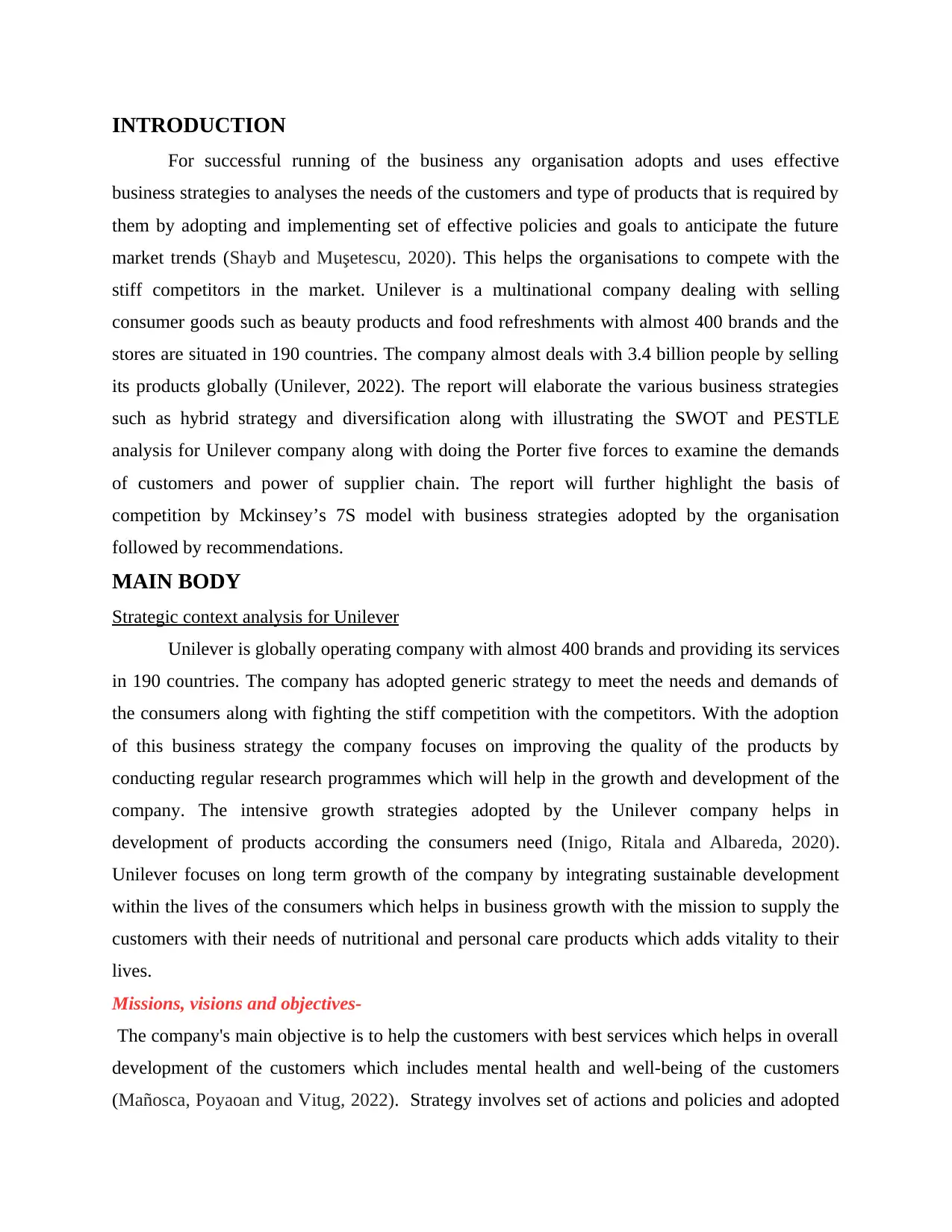
INTRODUCTION
For successful running of the business any organisation adopts and uses effective
business strategies to analyses the needs of the customers and type of products that is required by
them by adopting and implementing set of effective policies and goals to anticipate the future
market trends (Shayb and Muşetescu, 2020). This helps the organisations to compete with the
stiff competitors in the market. Unilever is a multinational company dealing with selling
consumer goods such as beauty products and food refreshments with almost 400 brands and the
stores are situated in 190 countries. The company almost deals with 3.4 billion people by selling
its products globally (Unilever, 2022). The report will elaborate the various business strategies
such as hybrid strategy and diversification along with illustrating the SWOT and PESTLE
analysis for Unilever company along with doing the Porter five forces to examine the demands
of customers and power of supplier chain. The report will further highlight the basis of
competition by Mckinsey’s 7S model with business strategies adopted by the organisation
followed by recommendations.
MAIN BODY
Strategic context analysis for Unilever
Unilever is globally operating company with almost 400 brands and providing its services
in 190 countries. The company has adopted generic strategy to meet the needs and demands of
the consumers along with fighting the stiff competition with the competitors. With the adoption
of this business strategy the company focuses on improving the quality of the products by
conducting regular research programmes which will help in the growth and development of the
company. The intensive growth strategies adopted by the Unilever company helps in
development of products according the consumers need (Inigo, Ritala and Albareda, 2020).
Unilever focuses on long term growth of the company by integrating sustainable development
within the lives of the consumers which helps in business growth with the mission to supply the
customers with their needs of nutritional and personal care products which adds vitality to their
lives.
Missions, visions and objectives-
The company's main objective is to help the customers with best services which helps in overall
development of the customers which includes mental health and well-being of the customers
(Mañosca, Poyaoan and Vitug, 2022). Strategy involves set of actions and policies and adopted
For successful running of the business any organisation adopts and uses effective
business strategies to analyses the needs of the customers and type of products that is required by
them by adopting and implementing set of effective policies and goals to anticipate the future
market trends (Shayb and Muşetescu, 2020). This helps the organisations to compete with the
stiff competitors in the market. Unilever is a multinational company dealing with selling
consumer goods such as beauty products and food refreshments with almost 400 brands and the
stores are situated in 190 countries. The company almost deals with 3.4 billion people by selling
its products globally (Unilever, 2022). The report will elaborate the various business strategies
such as hybrid strategy and diversification along with illustrating the SWOT and PESTLE
analysis for Unilever company along with doing the Porter five forces to examine the demands
of customers and power of supplier chain. The report will further highlight the basis of
competition by Mckinsey’s 7S model with business strategies adopted by the organisation
followed by recommendations.
MAIN BODY
Strategic context analysis for Unilever
Unilever is globally operating company with almost 400 brands and providing its services
in 190 countries. The company has adopted generic strategy to meet the needs and demands of
the consumers along with fighting the stiff competition with the competitors. With the adoption
of this business strategy the company focuses on improving the quality of the products by
conducting regular research programmes which will help in the growth and development of the
company. The intensive growth strategies adopted by the Unilever company helps in
development of products according the consumers need (Inigo, Ritala and Albareda, 2020).
Unilever focuses on long term growth of the company by integrating sustainable development
within the lives of the consumers which helps in business growth with the mission to supply the
customers with their needs of nutritional and personal care products which adds vitality to their
lives.
Missions, visions and objectives-
The company's main objective is to help the customers with best services which helps in overall
development of the customers which includes mental health and well-being of the customers
(Mañosca, Poyaoan and Vitug, 2022). Strategy involves set of actions and policies and adopted
⊘ This is a preview!⊘
Do you want full access?
Subscribe today to unlock all pages.

Trusted by 1+ million students worldwide
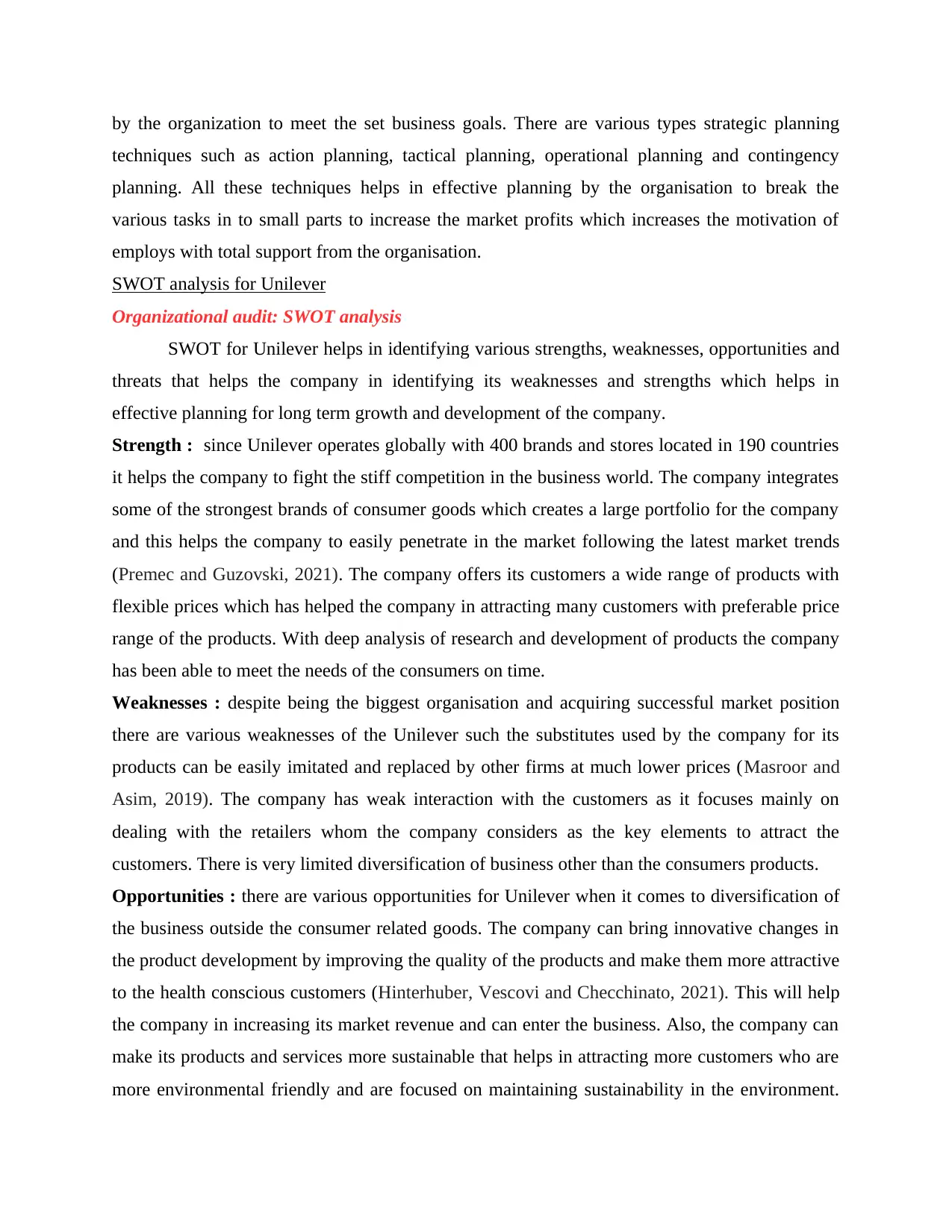
by the organization to meet the set business goals. There are various types strategic planning
techniques such as action planning, tactical planning, operational planning and contingency
planning. All these techniques helps in effective planning by the organisation to break the
various tasks in to small parts to increase the market profits which increases the motivation of
employs with total support from the organisation.
SWOT analysis for Unilever
Organizational audit: SWOT analysis
SWOT for Unilever helps in identifying various strengths, weaknesses, opportunities and
threats that helps the company in identifying its weaknesses and strengths which helps in
effective planning for long term growth and development of the company.
Strength : since Unilever operates globally with 400 brands and stores located in 190 countries
it helps the company to fight the stiff competition in the business world. The company integrates
some of the strongest brands of consumer goods which creates a large portfolio for the company
and this helps the company to easily penetrate in the market following the latest market trends
(Premec and Guzovski, 2021). The company offers its customers a wide range of products with
flexible prices which has helped the company in attracting many customers with preferable price
range of the products. With deep analysis of research and development of products the company
has been able to meet the needs of the consumers on time.
Weaknesses : despite being the biggest organisation and acquiring successful market position
there are various weaknesses of the Unilever such the substitutes used by the company for its
products can be easily imitated and replaced by other firms at much lower prices (Masroor and
Asim, 2019). The company has weak interaction with the customers as it focuses mainly on
dealing with the retailers whom the company considers as the key elements to attract the
customers. There is very limited diversification of business other than the consumers products.
Opportunities : there are various opportunities for Unilever when it comes to diversification of
the business outside the consumer related goods. The company can bring innovative changes in
the product development by improving the quality of the products and make them more attractive
to the health conscious customers (Hinterhuber, Vescovi and Checchinato, 2021). This will help
the company in increasing its market revenue and can enter the business. Also, the company can
make its products and services more sustainable that helps in attracting more customers who are
more environmental friendly and are focused on maintaining sustainability in the environment.
techniques such as action planning, tactical planning, operational planning and contingency
planning. All these techniques helps in effective planning by the organisation to break the
various tasks in to small parts to increase the market profits which increases the motivation of
employs with total support from the organisation.
SWOT analysis for Unilever
Organizational audit: SWOT analysis
SWOT for Unilever helps in identifying various strengths, weaknesses, opportunities and
threats that helps the company in identifying its weaknesses and strengths which helps in
effective planning for long term growth and development of the company.
Strength : since Unilever operates globally with 400 brands and stores located in 190 countries
it helps the company to fight the stiff competition in the business world. The company integrates
some of the strongest brands of consumer goods which creates a large portfolio for the company
and this helps the company to easily penetrate in the market following the latest market trends
(Premec and Guzovski, 2021). The company offers its customers a wide range of products with
flexible prices which has helped the company in attracting many customers with preferable price
range of the products. With deep analysis of research and development of products the company
has been able to meet the needs of the consumers on time.
Weaknesses : despite being the biggest organisation and acquiring successful market position
there are various weaknesses of the Unilever such the substitutes used by the company for its
products can be easily imitated and replaced by other firms at much lower prices (Masroor and
Asim, 2019). The company has weak interaction with the customers as it focuses mainly on
dealing with the retailers whom the company considers as the key elements to attract the
customers. There is very limited diversification of business other than the consumers products.
Opportunities : there are various opportunities for Unilever when it comes to diversification of
the business outside the consumer related goods. The company can bring innovative changes in
the product development by improving the quality of the products and make them more attractive
to the health conscious customers (Hinterhuber, Vescovi and Checchinato, 2021). This will help
the company in increasing its market revenue and can enter the business. Also, the company can
make its products and services more sustainable that helps in attracting more customers who are
more environmental friendly and are focused on maintaining sustainability in the environment.
Paraphrase This Document
Need a fresh take? Get an instant paraphrase of this document with our AI Paraphraser

This will help in the market development for Unilever company by increasing the customers
base.
Threats : the Unilever company faces major threats from product imitation by various small and
local firms operating within the market that imitates the substitutes of the products and sell them
at lower prices which results in cutting down the customers for Unilever company. There are
many retailers in the market who creates a major threat for the Unilever company by selling
goods and products of their own brands (Williams, Whiteman and Kennedy, 2021). With the
recent economic recession faced by many countries due to COVID changes the customers'
behaviour to buy low priced products due to the Unilever company faces decrease rates of
market revenue due to high prices of its products.
Impact and influence which the macro environment has on an organization-
Environmental analysis: PESTLE and Porter’s Five Forces model
The organization has much impact of the macro environment and these can be analysed by the
using the PESTLE, SWOT and the Porter's five forces in order to knowe the competition and the
market share of the company. Unilever's market competition and the macro environment can be
done by using these theoretical theories.
PESTLE analysis-
The pestle analysis of the Unilever company will help in examining the complications which th
company faces by the external factors such as-
Political Factors- The Unilever is highly subjected with the strict regulations and guidelines
which are announced by the European Commission and if the company is not able to comply
with these guidelines, then they have to face the penalties as well as the legal issues (Vlados and
Chatzinikolaou, 2019). The restrictions and guidelines of the Unilever regarding the imports and
exports hinders the success of this company.
Economic Factors- The economy of the country has the direct impact on the buying behaviour
of the consumers as they have less interest in buying the expensive products of the company. The
costumers have the direct impact on the supplies of the Unilever company when the products are
not in demand as this has the negative impact on the cash flows and the profits of the company.
Social Factors- The Unilever company has now decided to focus more on increasing the
reputation of the company. They emphasize more on the issues which are related to the social
base.
Threats : the Unilever company faces major threats from product imitation by various small and
local firms operating within the market that imitates the substitutes of the products and sell them
at lower prices which results in cutting down the customers for Unilever company. There are
many retailers in the market who creates a major threat for the Unilever company by selling
goods and products of their own brands (Williams, Whiteman and Kennedy, 2021). With the
recent economic recession faced by many countries due to COVID changes the customers'
behaviour to buy low priced products due to the Unilever company faces decrease rates of
market revenue due to high prices of its products.
Impact and influence which the macro environment has on an organization-
Environmental analysis: PESTLE and Porter’s Five Forces model
The organization has much impact of the macro environment and these can be analysed by the
using the PESTLE, SWOT and the Porter's five forces in order to knowe the competition and the
market share of the company. Unilever's market competition and the macro environment can be
done by using these theoretical theories.
PESTLE analysis-
The pestle analysis of the Unilever company will help in examining the complications which th
company faces by the external factors such as-
Political Factors- The Unilever is highly subjected with the strict regulations and guidelines
which are announced by the European Commission and if the company is not able to comply
with these guidelines, then they have to face the penalties as well as the legal issues (Vlados and
Chatzinikolaou, 2019). The restrictions and guidelines of the Unilever regarding the imports and
exports hinders the success of this company.
Economic Factors- The economy of the country has the direct impact on the buying behaviour
of the consumers as they have less interest in buying the expensive products of the company. The
costumers have the direct impact on the supplies of the Unilever company when the products are
not in demand as this has the negative impact on the cash flows and the profits of the company.
Social Factors- The Unilever company has now decided to focus more on increasing the
reputation of the company. They emphasize more on the issues which are related to the social
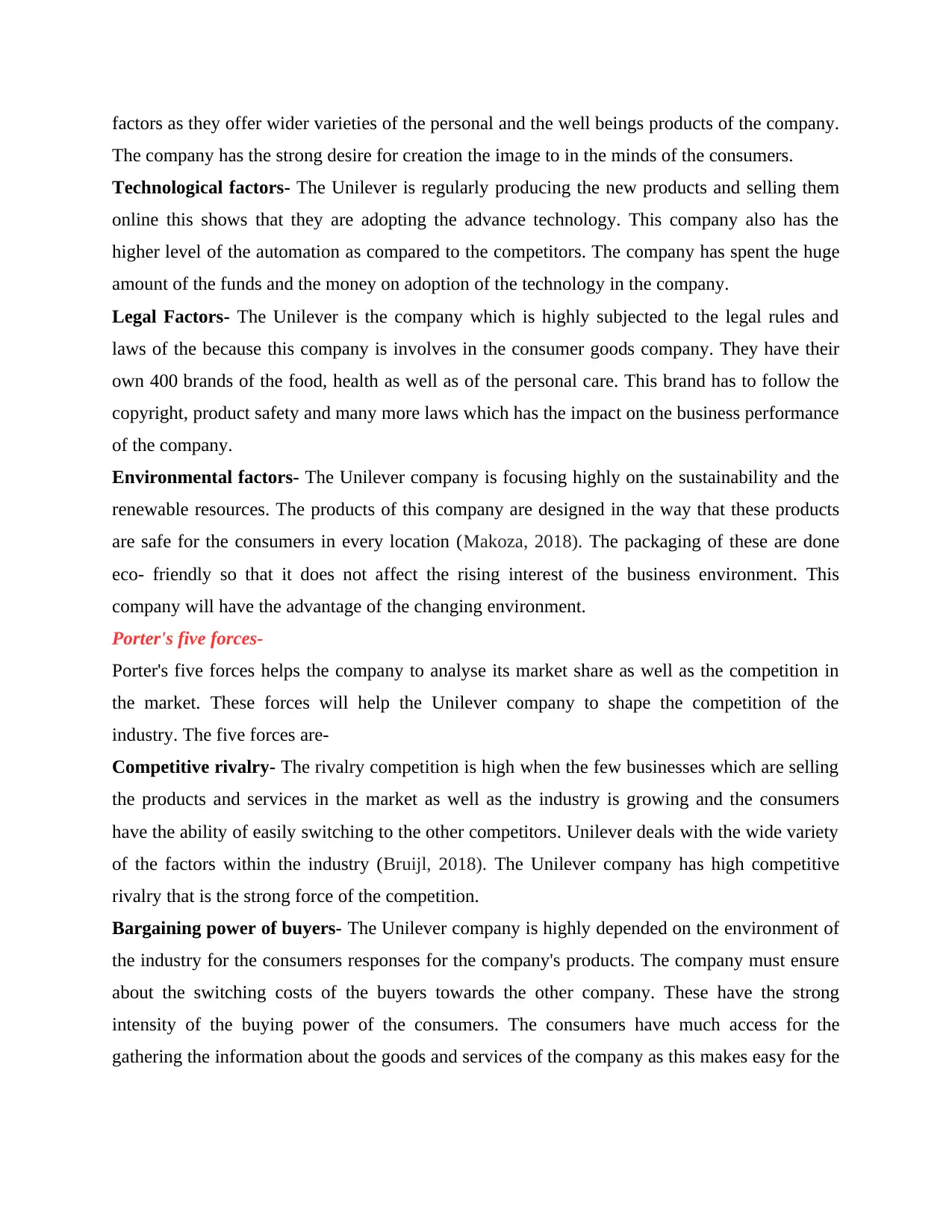
factors as they offer wider varieties of the personal and the well beings products of the company.
The company has the strong desire for creation the image to in the minds of the consumers.
Technological factors- The Unilever is regularly producing the new products and selling them
online this shows that they are adopting the advance technology. This company also has the
higher level of the automation as compared to the competitors. The company has spent the huge
amount of the funds and the money on adoption of the technology in the company.
Legal Factors- The Unilever is the company which is highly subjected to the legal rules and
laws of the because this company is involves in the consumer goods company. They have their
own 400 brands of the food, health as well as of the personal care. This brand has to follow the
copyright, product safety and many more laws which has the impact on the business performance
of the company.
Environmental factors- The Unilever company is focusing highly on the sustainability and the
renewable resources. The products of this company are designed in the way that these products
are safe for the consumers in every location (Makoza, 2018). The packaging of these are done
eco- friendly so that it does not affect the rising interest of the business environment. This
company will have the advantage of the changing environment.
Porter's five forces-
Porter's five forces helps the company to analyse its market share as well as the competition in
the market. These forces will help the Unilever company to shape the competition of the
industry. The five forces are-
Competitive rivalry- The rivalry competition is high when the few businesses which are selling
the products and services in the market as well as the industry is growing and the consumers
have the ability of easily switching to the other competitors. Unilever deals with the wide variety
of the factors within the industry (Bruijl, 2018). The Unilever company has high competitive
rivalry that is the strong force of the competition.
Bargaining power of buyers- The Unilever company is highly depended on the environment of
the industry for the consumers responses for the company's products. The company must ensure
about the switching costs of the buyers towards the other company. These have the strong
intensity of the buying power of the consumers. The consumers have much access for the
gathering the information about the goods and services of the company as this makes easy for the
The company has the strong desire for creation the image to in the minds of the consumers.
Technological factors- The Unilever is regularly producing the new products and selling them
online this shows that they are adopting the advance technology. This company also has the
higher level of the automation as compared to the competitors. The company has spent the huge
amount of the funds and the money on adoption of the technology in the company.
Legal Factors- The Unilever is the company which is highly subjected to the legal rules and
laws of the because this company is involves in the consumer goods company. They have their
own 400 brands of the food, health as well as of the personal care. This brand has to follow the
copyright, product safety and many more laws which has the impact on the business performance
of the company.
Environmental factors- The Unilever company is focusing highly on the sustainability and the
renewable resources. The products of this company are designed in the way that these products
are safe for the consumers in every location (Makoza, 2018). The packaging of these are done
eco- friendly so that it does not affect the rising interest of the business environment. This
company will have the advantage of the changing environment.
Porter's five forces-
Porter's five forces helps the company to analyse its market share as well as the competition in
the market. These forces will help the Unilever company to shape the competition of the
industry. The five forces are-
Competitive rivalry- The rivalry competition is high when the few businesses which are selling
the products and services in the market as well as the industry is growing and the consumers
have the ability of easily switching to the other competitors. Unilever deals with the wide variety
of the factors within the industry (Bruijl, 2018). The Unilever company has high competitive
rivalry that is the strong force of the competition.
Bargaining power of buyers- The Unilever company is highly depended on the environment of
the industry for the consumers responses for the company's products. The company must ensure
about the switching costs of the buyers towards the other company. These have the strong
intensity of the buying power of the consumers. The consumers have much access for the
gathering the information about the goods and services of the company as this makes easy for the
⊘ This is a preview!⊘
Do you want full access?
Subscribe today to unlock all pages.

Trusted by 1+ million students worldwide
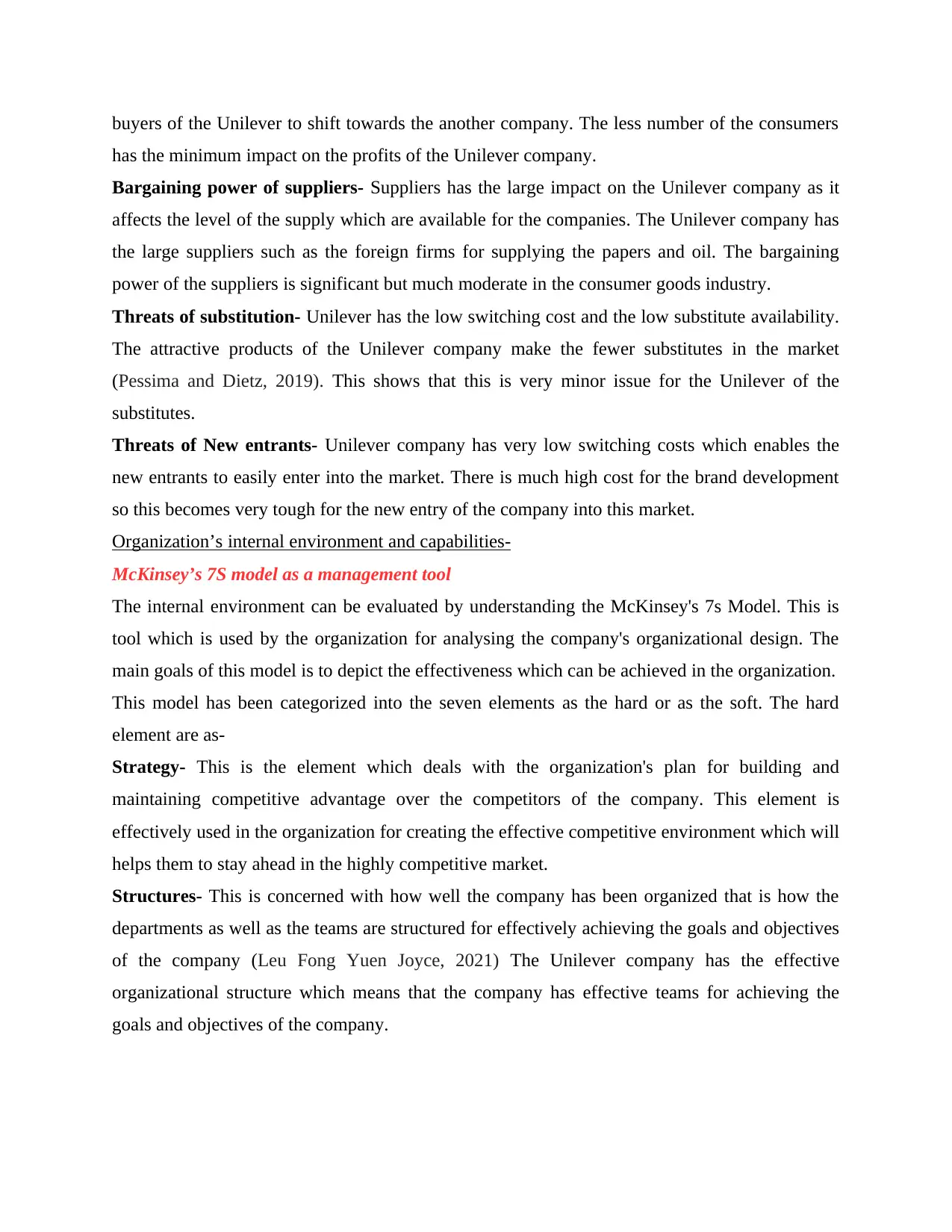
buyers of the Unilever to shift towards the another company. The less number of the consumers
has the minimum impact on the profits of the Unilever company.
Bargaining power of suppliers- Suppliers has the large impact on the Unilever company as it
affects the level of the supply which are available for the companies. The Unilever company has
the large suppliers such as the foreign firms for supplying the papers and oil. The bargaining
power of the suppliers is significant but much moderate in the consumer goods industry.
Threats of substitution- Unilever has the low switching cost and the low substitute availability.
The attractive products of the Unilever company make the fewer substitutes in the market
(Pessima and Dietz, 2019). This shows that this is very minor issue for the Unilever of the
substitutes.
Threats of New entrants- Unilever company has very low switching costs which enables the
new entrants to easily enter into the market. There is much high cost for the brand development
so this becomes very tough for the new entry of the company into this market.
Organization’s internal environment and capabilities-
McKinsey’s 7S model as a management tool
The internal environment can be evaluated by understanding the McKinsey's 7s Model. This is
tool which is used by the organization for analysing the company's organizational design. The
main goals of this model is to depict the effectiveness which can be achieved in the organization.
This model has been categorized into the seven elements as the hard or as the soft. The hard
element are as-
Strategy- This is the element which deals with the organization's plan for building and
maintaining competitive advantage over the competitors of the company. This element is
effectively used in the organization for creating the effective competitive environment which will
helps them to stay ahead in the highly competitive market.
Structures- This is concerned with how well the company has been organized that is how the
departments as well as the teams are structured for effectively achieving the goals and objectives
of the company (Leu Fong Yuen Joyce, 2021) The Unilever company has the effective
organizational structure which means that the company has effective teams for achieving the
goals and objectives of the company.
has the minimum impact on the profits of the Unilever company.
Bargaining power of suppliers- Suppliers has the large impact on the Unilever company as it
affects the level of the supply which are available for the companies. The Unilever company has
the large suppliers such as the foreign firms for supplying the papers and oil. The bargaining
power of the suppliers is significant but much moderate in the consumer goods industry.
Threats of substitution- Unilever has the low switching cost and the low substitute availability.
The attractive products of the Unilever company make the fewer substitutes in the market
(Pessima and Dietz, 2019). This shows that this is very minor issue for the Unilever of the
substitutes.
Threats of New entrants- Unilever company has very low switching costs which enables the
new entrants to easily enter into the market. There is much high cost for the brand development
so this becomes very tough for the new entry of the company into this market.
Organization’s internal environment and capabilities-
McKinsey’s 7S model as a management tool
The internal environment can be evaluated by understanding the McKinsey's 7s Model. This is
tool which is used by the organization for analysing the company's organizational design. The
main goals of this model is to depict the effectiveness which can be achieved in the organization.
This model has been categorized into the seven elements as the hard or as the soft. The hard
element are as-
Strategy- This is the element which deals with the organization's plan for building and
maintaining competitive advantage over the competitors of the company. This element is
effectively used in the organization for creating the effective competitive environment which will
helps them to stay ahead in the highly competitive market.
Structures- This is concerned with how well the company has been organized that is how the
departments as well as the teams are structured for effectively achieving the goals and objectives
of the company (Leu Fong Yuen Joyce, 2021) The Unilever company has the effective
organizational structure which means that the company has effective teams for achieving the
goals and objectives of the company.
Paraphrase This Document
Need a fresh take? Get an instant paraphrase of this document with our AI Paraphraser
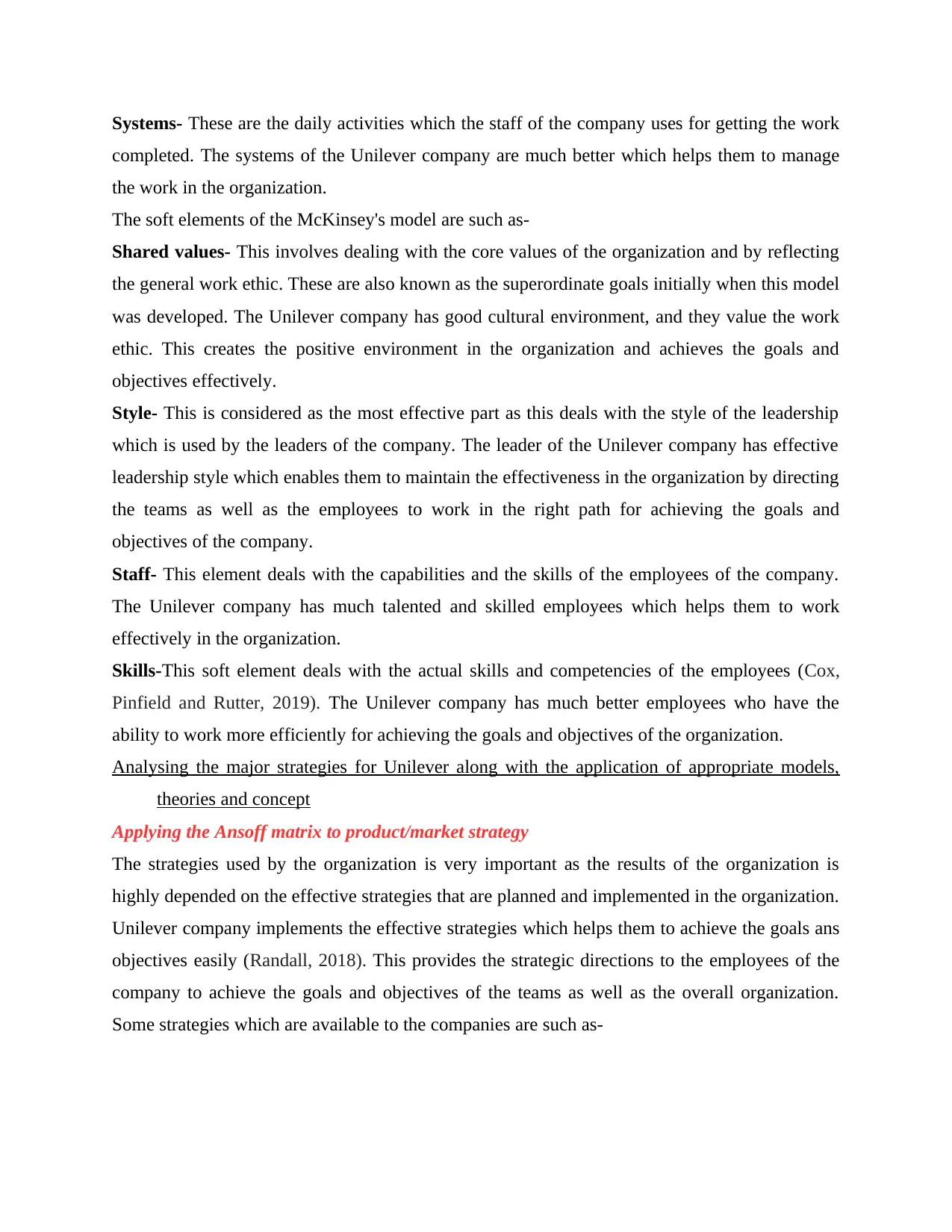
Systems- These are the daily activities which the staff of the company uses for getting the work
completed. The systems of the Unilever company are much better which helps them to manage
the work in the organization.
The soft elements of the McKinsey's model are such as-
Shared values- This involves dealing with the core values of the organization and by reflecting
the general work ethic. These are also known as the superordinate goals initially when this model
was developed. The Unilever company has good cultural environment, and they value the work
ethic. This creates the positive environment in the organization and achieves the goals and
objectives effectively.
Style- This is considered as the most effective part as this deals with the style of the leadership
which is used by the leaders of the company. The leader of the Unilever company has effective
leadership style which enables them to maintain the effectiveness in the organization by directing
the teams as well as the employees to work in the right path for achieving the goals and
objectives of the company.
Staff- This element deals with the capabilities and the skills of the employees of the company.
The Unilever company has much talented and skilled employees which helps them to work
effectively in the organization.
Skills-This soft element deals with the actual skills and competencies of the employees (Cox,
Pinfield and Rutter, 2019). The Unilever company has much better employees who have the
ability to work more efficiently for achieving the goals and objectives of the organization.
Analysing the major strategies for Unilever along with the application of appropriate models,
theories and concept
Applying the Ansoff matrix to product/market strategy
The strategies used by the organization is very important as the results of the organization is
highly depended on the effective strategies that are planned and implemented in the organization.
Unilever company implements the effective strategies which helps them to achieve the goals ans
objectives easily (Randall, 2018). This provides the strategic directions to the employees of the
company to achieve the goals and objectives of the teams as well as the overall organization.
Some strategies which are available to the companies are such as-
completed. The systems of the Unilever company are much better which helps them to manage
the work in the organization.
The soft elements of the McKinsey's model are such as-
Shared values- This involves dealing with the core values of the organization and by reflecting
the general work ethic. These are also known as the superordinate goals initially when this model
was developed. The Unilever company has good cultural environment, and they value the work
ethic. This creates the positive environment in the organization and achieves the goals and
objectives effectively.
Style- This is considered as the most effective part as this deals with the style of the leadership
which is used by the leaders of the company. The leader of the Unilever company has effective
leadership style which enables them to maintain the effectiveness in the organization by directing
the teams as well as the employees to work in the right path for achieving the goals and
objectives of the company.
Staff- This element deals with the capabilities and the skills of the employees of the company.
The Unilever company has much talented and skilled employees which helps them to work
effectively in the organization.
Skills-This soft element deals with the actual skills and competencies of the employees (Cox,
Pinfield and Rutter, 2019). The Unilever company has much better employees who have the
ability to work more efficiently for achieving the goals and objectives of the organization.
Analysing the major strategies for Unilever along with the application of appropriate models,
theories and concept
Applying the Ansoff matrix to product/market strategy
The strategies used by the organization is very important as the results of the organization is
highly depended on the effective strategies that are planned and implemented in the organization.
Unilever company implements the effective strategies which helps them to achieve the goals ans
objectives easily (Randall, 2018). This provides the strategic directions to the employees of the
company to achieve the goals and objectives of the teams as well as the overall organization.
Some strategies which are available to the companies are such as-
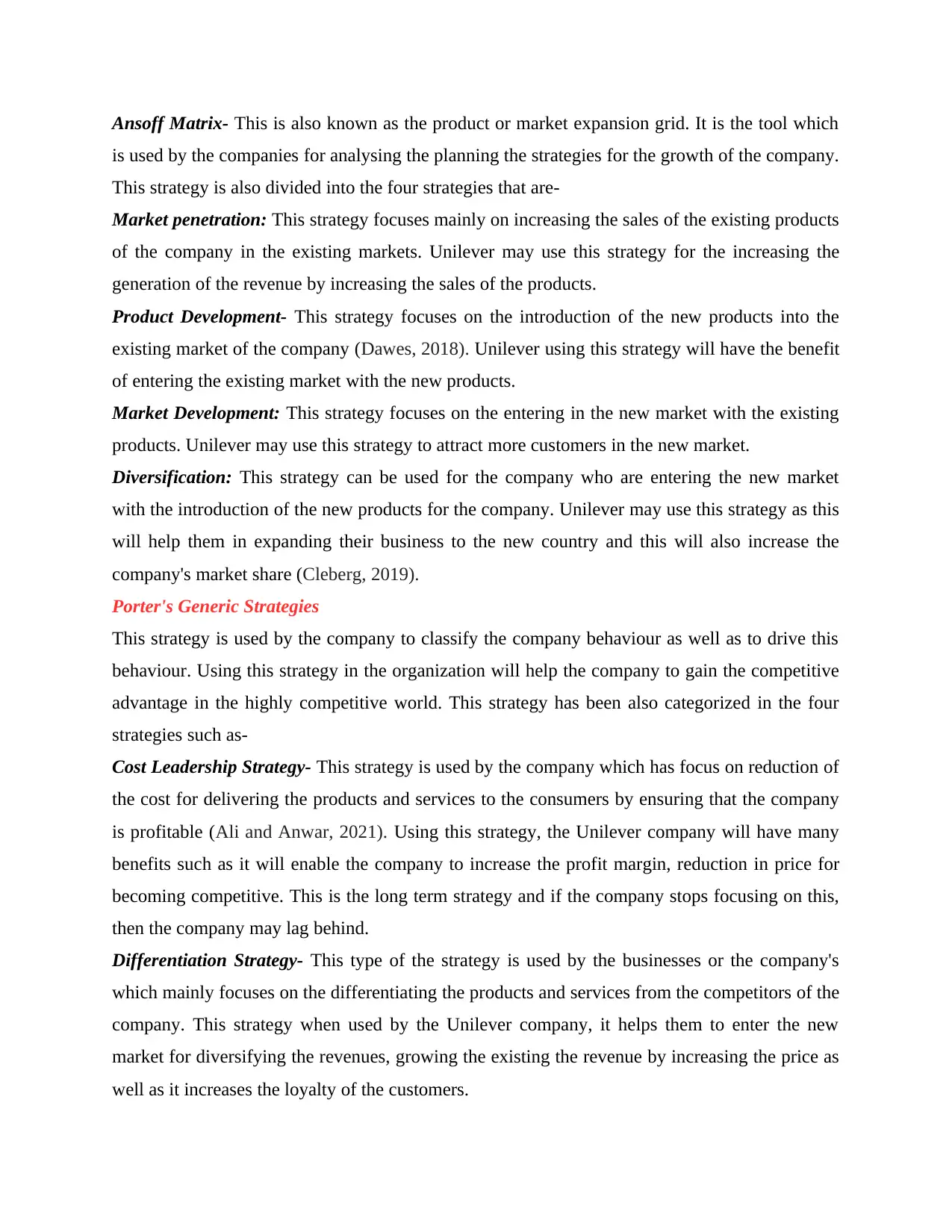
Ansoff Matrix- This is also known as the product or market expansion grid. It is the tool which
is used by the companies for analysing the planning the strategies for the growth of the company.
This strategy is also divided into the four strategies that are-
Market penetration: This strategy focuses mainly on increasing the sales of the existing products
of the company in the existing markets. Unilever may use this strategy for the increasing the
generation of the revenue by increasing the sales of the products.
Product Development- This strategy focuses on the introduction of the new products into the
existing market of the company (Dawes, 2018). Unilever using this strategy will have the benefit
of entering the existing market with the new products.
Market Development: This strategy focuses on the entering in the new market with the existing
products. Unilever may use this strategy to attract more customers in the new market.
Diversification: This strategy can be used for the company who are entering the new market
with the introduction of the new products for the company. Unilever may use this strategy as this
will help them in expanding their business to the new country and this will also increase the
company's market share (Cleberg, 2019).
Porter's Generic Strategies
This strategy is used by the company to classify the company behaviour as well as to drive this
behaviour. Using this strategy in the organization will help the company to gain the competitive
advantage in the highly competitive world. This strategy has been also categorized in the four
strategies such as-
Cost Leadership Strategy- This strategy is used by the company which has focus on reduction of
the cost for delivering the products and services to the consumers by ensuring that the company
is profitable (Ali and Anwar, 2021). Using this strategy, the Unilever company will have many
benefits such as it will enable the company to increase the profit margin, reduction in price for
becoming competitive. This is the long term strategy and if the company stops focusing on this,
then the company may lag behind.
Differentiation Strategy- This type of the strategy is used by the businesses or the company's
which mainly focuses on the differentiating the products and services from the competitors of the
company. This strategy when used by the Unilever company, it helps them to enter the new
market for diversifying the revenues, growing the existing the revenue by increasing the price as
well as it increases the loyalty of the customers.
is used by the companies for analysing the planning the strategies for the growth of the company.
This strategy is also divided into the four strategies that are-
Market penetration: This strategy focuses mainly on increasing the sales of the existing products
of the company in the existing markets. Unilever may use this strategy for the increasing the
generation of the revenue by increasing the sales of the products.
Product Development- This strategy focuses on the introduction of the new products into the
existing market of the company (Dawes, 2018). Unilever using this strategy will have the benefit
of entering the existing market with the new products.
Market Development: This strategy focuses on the entering in the new market with the existing
products. Unilever may use this strategy to attract more customers in the new market.
Diversification: This strategy can be used for the company who are entering the new market
with the introduction of the new products for the company. Unilever may use this strategy as this
will help them in expanding their business to the new country and this will also increase the
company's market share (Cleberg, 2019).
Porter's Generic Strategies
This strategy is used by the company to classify the company behaviour as well as to drive this
behaviour. Using this strategy in the organization will help the company to gain the competitive
advantage in the highly competitive world. This strategy has been also categorized in the four
strategies such as-
Cost Leadership Strategy- This strategy is used by the company which has focus on reduction of
the cost for delivering the products and services to the consumers by ensuring that the company
is profitable (Ali and Anwar, 2021). Using this strategy, the Unilever company will have many
benefits such as it will enable the company to increase the profit margin, reduction in price for
becoming competitive. This is the long term strategy and if the company stops focusing on this,
then the company may lag behind.
Differentiation Strategy- This type of the strategy is used by the businesses or the company's
which mainly focuses on the differentiating the products and services from the competitors of the
company. This strategy when used by the Unilever company, it helps them to enter the new
market for diversifying the revenues, growing the existing the revenue by increasing the price as
well as it increases the loyalty of the customers.
⊘ This is a preview!⊘
Do you want full access?
Subscribe today to unlock all pages.

Trusted by 1+ million students worldwide
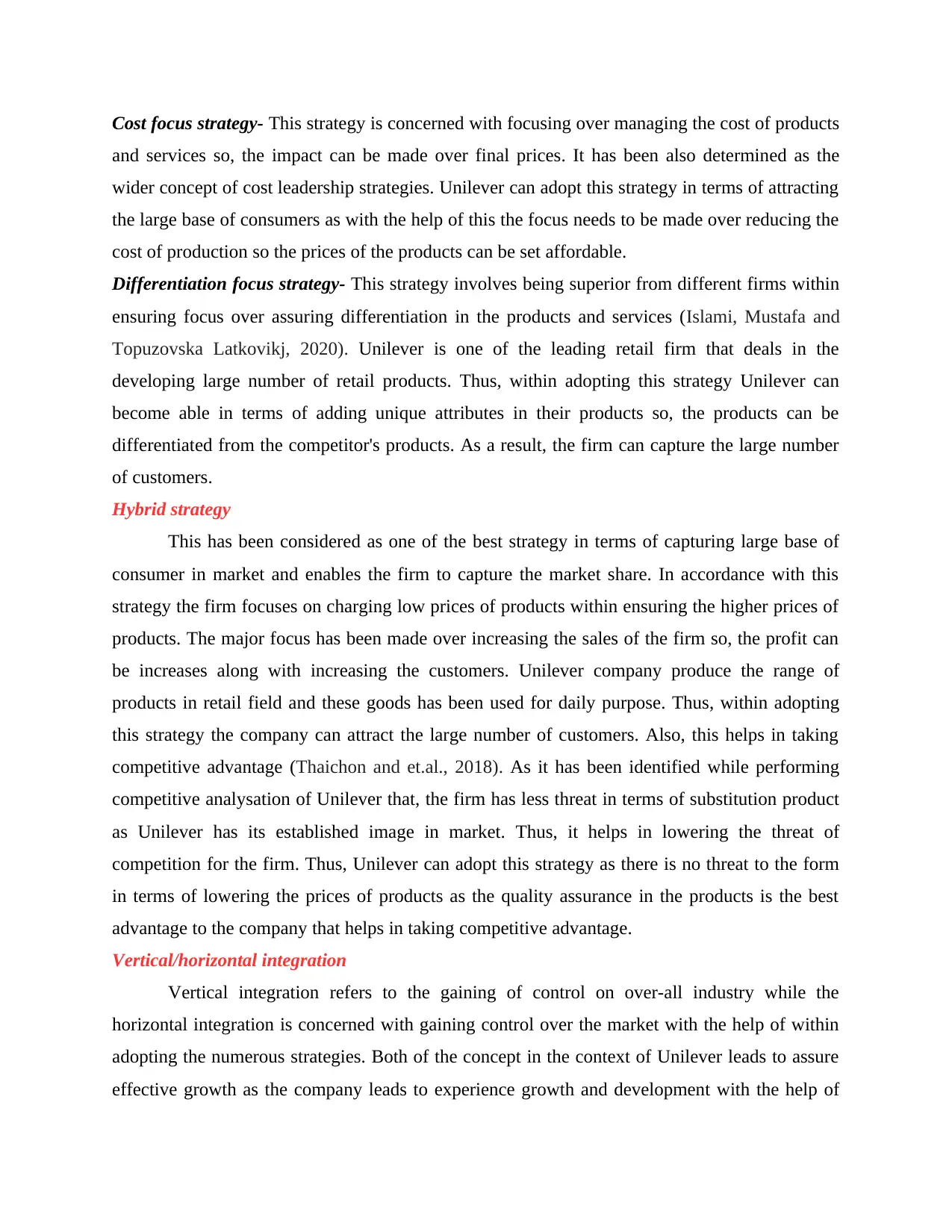
Cost focus strategy- This strategy is concerned with focusing over managing the cost of products
and services so, the impact can be made over final prices. It has been also determined as the
wider concept of cost leadership strategies. Unilever can adopt this strategy in terms of attracting
the large base of consumers as with the help of this the focus needs to be made over reducing the
cost of production so the prices of the products can be set affordable.
Differentiation focus strategy- This strategy involves being superior from different firms within
ensuring focus over assuring differentiation in the products and services (Islami, Mustafa and
Topuzovska Latkovikj, 2020). Unilever is one of the leading retail firm that deals in the
developing large number of retail products. Thus, within adopting this strategy Unilever can
become able in terms of adding unique attributes in their products so, the products can be
differentiated from the competitor's products. As a result, the firm can capture the large number
of customers.
Hybrid strategy
This has been considered as one of the best strategy in terms of capturing large base of
consumer in market and enables the firm to capture the market share. In accordance with this
strategy the firm focuses on charging low prices of products within ensuring the higher prices of
products. The major focus has been made over increasing the sales of the firm so, the profit can
be increases along with increasing the customers. Unilever company produce the range of
products in retail field and these goods has been used for daily purpose. Thus, within adopting
this strategy the company can attract the large number of customers. Also, this helps in taking
competitive advantage (Thaichon and et.al., 2018). As it has been identified while performing
competitive analysation of Unilever that, the firm has less threat in terms of substitution product
as Unilever has its established image in market. Thus, it helps in lowering the threat of
competition for the firm. Thus, Unilever can adopt this strategy as there is no threat to the form
in terms of lowering the prices of products as the quality assurance in the products is the best
advantage to the company that helps in taking competitive advantage.
Vertical/horizontal integration
Vertical integration refers to the gaining of control on over-all industry while the
horizontal integration is concerned with gaining control over the market with the help of within
adopting the numerous strategies. Both of the concept in the context of Unilever leads to assure
effective growth as the company leads to experience growth and development with the help of
and services so, the impact can be made over final prices. It has been also determined as the
wider concept of cost leadership strategies. Unilever can adopt this strategy in terms of attracting
the large base of consumers as with the help of this the focus needs to be made over reducing the
cost of production so the prices of the products can be set affordable.
Differentiation focus strategy- This strategy involves being superior from different firms within
ensuring focus over assuring differentiation in the products and services (Islami, Mustafa and
Topuzovska Latkovikj, 2020). Unilever is one of the leading retail firm that deals in the
developing large number of retail products. Thus, within adopting this strategy Unilever can
become able in terms of adding unique attributes in their products so, the products can be
differentiated from the competitor's products. As a result, the firm can capture the large number
of customers.
Hybrid strategy
This has been considered as one of the best strategy in terms of capturing large base of
consumer in market and enables the firm to capture the market share. In accordance with this
strategy the firm focuses on charging low prices of products within ensuring the higher prices of
products. The major focus has been made over increasing the sales of the firm so, the profit can
be increases along with increasing the customers. Unilever company produce the range of
products in retail field and these goods has been used for daily purpose. Thus, within adopting
this strategy the company can attract the large number of customers. Also, this helps in taking
competitive advantage (Thaichon and et.al., 2018). As it has been identified while performing
competitive analysation of Unilever that, the firm has less threat in terms of substitution product
as Unilever has its established image in market. Thus, it helps in lowering the threat of
competition for the firm. Thus, Unilever can adopt this strategy as there is no threat to the form
in terms of lowering the prices of products as the quality assurance in the products is the best
advantage to the company that helps in taking competitive advantage.
Vertical/horizontal integration
Vertical integration refers to the gaining of control on over-all industry while the
horizontal integration is concerned with gaining control over the market with the help of within
adopting the numerous strategies. Both of the concept in the context of Unilever leads to assure
effective growth as the company leads to experience growth and development with the help of
Paraphrase This Document
Need a fresh take? Get an instant paraphrase of this document with our AI Paraphraser
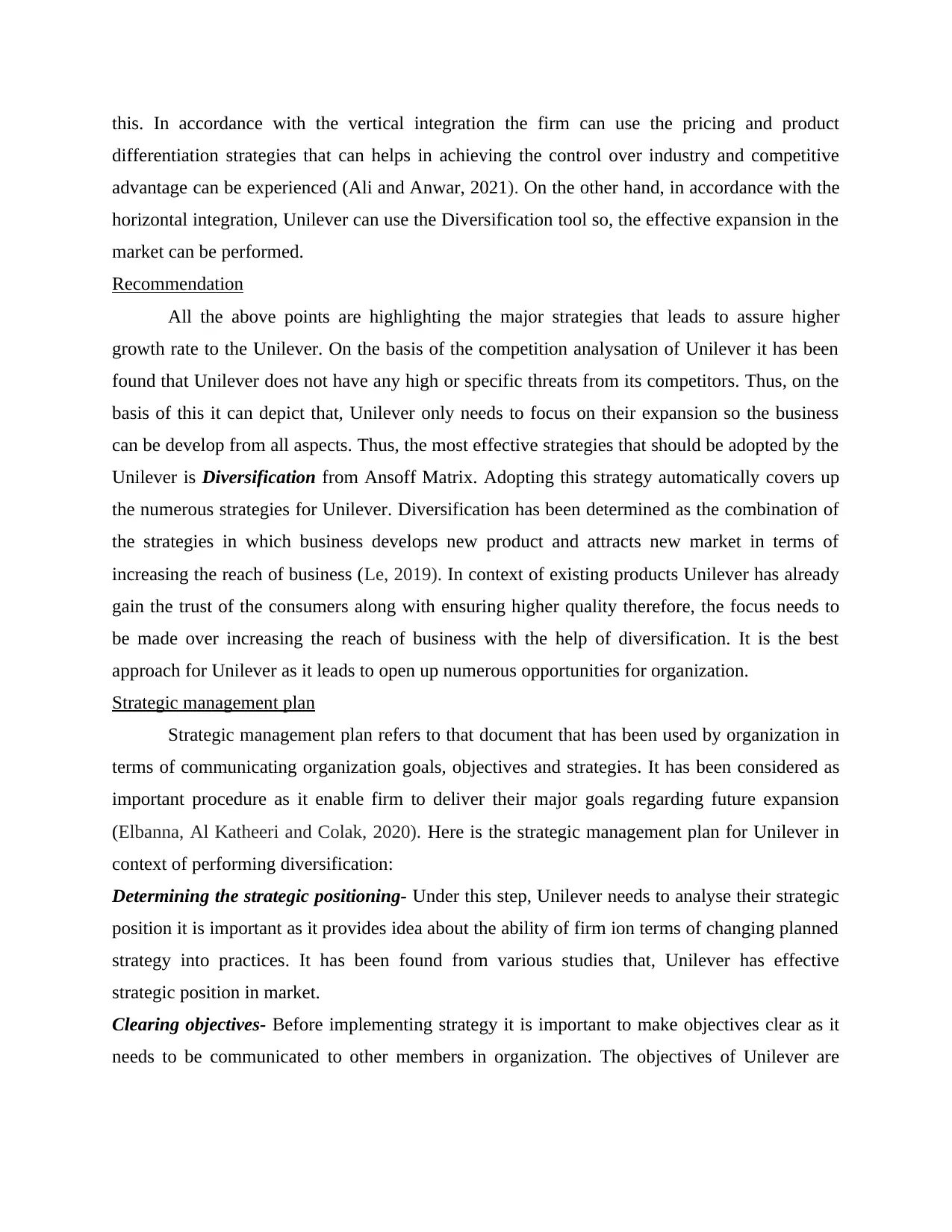
this. In accordance with the vertical integration the firm can use the pricing and product
differentiation strategies that can helps in achieving the control over industry and competitive
advantage can be experienced (Ali and Anwar, 2021). On the other hand, in accordance with the
horizontal integration, Unilever can use the Diversification tool so, the effective expansion in the
market can be performed.
Recommendation
All the above points are highlighting the major strategies that leads to assure higher
growth rate to the Unilever. On the basis of the competition analysation of Unilever it has been
found that Unilever does not have any high or specific threats from its competitors. Thus, on the
basis of this it can depict that, Unilever only needs to focus on their expansion so the business
can be develop from all aspects. Thus, the most effective strategies that should be adopted by the
Unilever is Diversification from Ansoff Matrix. Adopting this strategy automatically covers up
the numerous strategies for Unilever. Diversification has been determined as the combination of
the strategies in which business develops new product and attracts new market in terms of
increasing the reach of business (Le, 2019). In context of existing products Unilever has already
gain the trust of the consumers along with ensuring higher quality therefore, the focus needs to
be made over increasing the reach of business with the help of diversification. It is the best
approach for Unilever as it leads to open up numerous opportunities for organization.
Strategic management plan
Strategic management plan refers to that document that has been used by organization in
terms of communicating organization goals, objectives and strategies. It has been considered as
important procedure as it enable firm to deliver their major goals regarding future expansion
(Elbanna, Al Katheeri and Colak, 2020). Here is the strategic management plan for Unilever in
context of performing diversification:
Determining the strategic positioning- Under this step, Unilever needs to analyse their strategic
position it is important as it provides idea about the ability of firm ion terms of changing planned
strategy into practices. It has been found from various studies that, Unilever has effective
strategic position in market.
Clearing objectives- Before implementing strategy it is important to make objectives clear as it
needs to be communicated to other members in organization. The objectives of Unilever are
differentiation strategies that can helps in achieving the control over industry and competitive
advantage can be experienced (Ali and Anwar, 2021). On the other hand, in accordance with the
horizontal integration, Unilever can use the Diversification tool so, the effective expansion in the
market can be performed.
Recommendation
All the above points are highlighting the major strategies that leads to assure higher
growth rate to the Unilever. On the basis of the competition analysation of Unilever it has been
found that Unilever does not have any high or specific threats from its competitors. Thus, on the
basis of this it can depict that, Unilever only needs to focus on their expansion so the business
can be develop from all aspects. Thus, the most effective strategies that should be adopted by the
Unilever is Diversification from Ansoff Matrix. Adopting this strategy automatically covers up
the numerous strategies for Unilever. Diversification has been determined as the combination of
the strategies in which business develops new product and attracts new market in terms of
increasing the reach of business (Le, 2019). In context of existing products Unilever has already
gain the trust of the consumers along with ensuring higher quality therefore, the focus needs to
be made over increasing the reach of business with the help of diversification. It is the best
approach for Unilever as it leads to open up numerous opportunities for organization.
Strategic management plan
Strategic management plan refers to that document that has been used by organization in
terms of communicating organization goals, objectives and strategies. It has been considered as
important procedure as it enable firm to deliver their major goals regarding future expansion
(Elbanna, Al Katheeri and Colak, 2020). Here is the strategic management plan for Unilever in
context of performing diversification:
Determining the strategic positioning- Under this step, Unilever needs to analyse their strategic
position it is important as it provides idea about the ability of firm ion terms of changing planned
strategy into practices. It has been found from various studies that, Unilever has effective
strategic position in market.
Clearing objectives- Before implementing strategy it is important to make objectives clear as it
needs to be communicated to other members in organization. The objectives of Unilever are
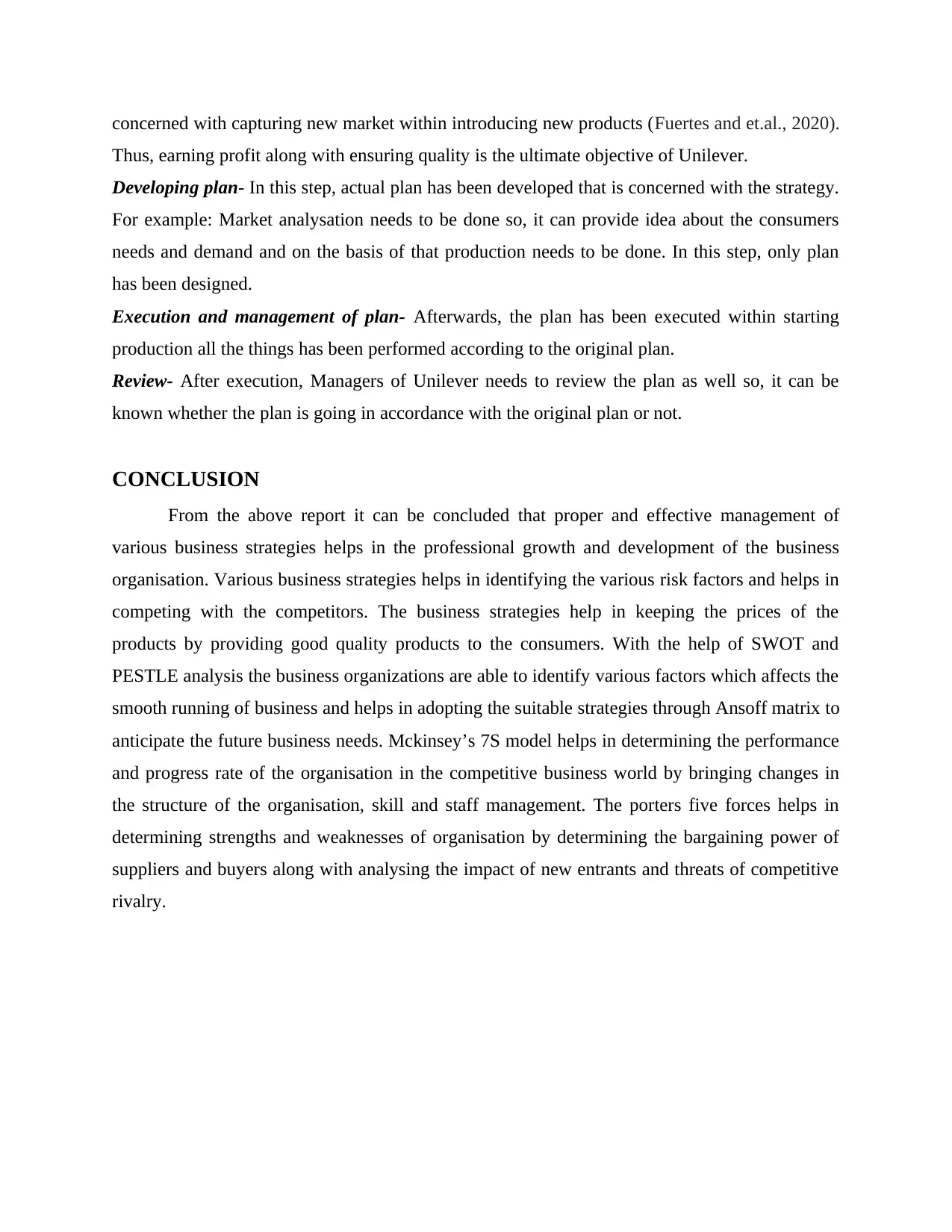
concerned with capturing new market within introducing new products (Fuertes and et.al., 2020).
Thus, earning profit along with ensuring quality is the ultimate objective of Unilever.
Developing plan- In this step, actual plan has been developed that is concerned with the strategy.
For example: Market analysation needs to be done so, it can provide idea about the consumers
needs and demand and on the basis of that production needs to be done. In this step, only plan
has been designed.
Execution and management of plan- Afterwards, the plan has been executed within starting
production all the things has been performed according to the original plan.
Review- After execution, Managers of Unilever needs to review the plan as well so, it can be
known whether the plan is going in accordance with the original plan or not.
CONCLUSION
From the above report it can be concluded that proper and effective management of
various business strategies helps in the professional growth and development of the business
organisation. Various business strategies helps in identifying the various risk factors and helps in
competing with the competitors. The business strategies help in keeping the prices of the
products by providing good quality products to the consumers. With the help of SWOT and
PESTLE analysis the business organizations are able to identify various factors which affects the
smooth running of business and helps in adopting the suitable strategies through Ansoff matrix to
anticipate the future business needs. Mckinsey’s 7S model helps in determining the performance
and progress rate of the organisation in the competitive business world by bringing changes in
the structure of the organisation, skill and staff management. The porters five forces helps in
determining strengths and weaknesses of organisation by determining the bargaining power of
suppliers and buyers along with analysing the impact of new entrants and threats of competitive
rivalry.
Thus, earning profit along with ensuring quality is the ultimate objective of Unilever.
Developing plan- In this step, actual plan has been developed that is concerned with the strategy.
For example: Market analysation needs to be done so, it can provide idea about the consumers
needs and demand and on the basis of that production needs to be done. In this step, only plan
has been designed.
Execution and management of plan- Afterwards, the plan has been executed within starting
production all the things has been performed according to the original plan.
Review- After execution, Managers of Unilever needs to review the plan as well so, it can be
known whether the plan is going in accordance with the original plan or not.
CONCLUSION
From the above report it can be concluded that proper and effective management of
various business strategies helps in the professional growth and development of the business
organisation. Various business strategies helps in identifying the various risk factors and helps in
competing with the competitors. The business strategies help in keeping the prices of the
products by providing good quality products to the consumers. With the help of SWOT and
PESTLE analysis the business organizations are able to identify various factors which affects the
smooth running of business and helps in adopting the suitable strategies through Ansoff matrix to
anticipate the future business needs. Mckinsey’s 7S model helps in determining the performance
and progress rate of the organisation in the competitive business world by bringing changes in
the structure of the organisation, skill and staff management. The porters five forces helps in
determining strengths and weaknesses of organisation by determining the bargaining power of
suppliers and buyers along with analysing the impact of new entrants and threats of competitive
rivalry.
⊘ This is a preview!⊘
Do you want full access?
Subscribe today to unlock all pages.

Trusted by 1+ million students worldwide
1 out of 14
Related Documents
Your All-in-One AI-Powered Toolkit for Academic Success.
+13062052269
info@desklib.com
Available 24*7 on WhatsApp / Email
![[object Object]](/_next/static/media/star-bottom.7253800d.svg)
Unlock your academic potential
Copyright © 2020–2025 A2Z Services. All Rights Reserved. Developed and managed by ZUCOL.




